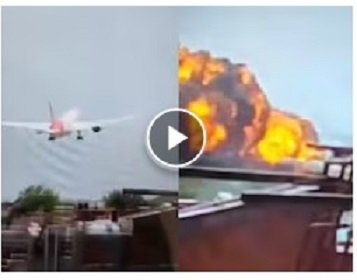Last Updated on June 12, 2025 11:05 am by BIZNAMA NEWS
By R. Suryamurthy
The tragic crash of Air India Flight AI171 shortly after take-off from Ahmedabad’s Sardar Vallabhbhai Patel International Airport has plunged the nation into mourning and triggered a high-stakes aviation investigation. The Boeing 787-8 Dreamliner, bound for London, went down minutes after liftoff, killing all 242 people on board — 230 passengers and 12 crew members — in one of the deadliest aviation disasters in India’s modern history.
While families await answers, aviation experts and investigators are working urgently to piece together the final moments of the ill-fated flight.
Possible Causes Under Scrutiny
Preliminary theories suggest multiple possible causes for the crash, none yet confirmed. One leading hypothesis is a bird strike resulting in catastrophic engine failure. Retired senior pilot Capt. Saurabh Bhatnagar said that both engines may have failed after ingesting birds, rendering the aircraft unable to maintain lift. The plane crashed while flying at a low altitude between 625 and 825 feet — consistent with this theory.
Another explanation involves aerodynamic stall due to a premature retraction of flaps or insufficient speed. Aviation analyst Sanjay Lazar pointed out that an early flap retraction during the climb phase could have reduced lift dramatically, causing the aircraft to lose altitude.
Environmental conditions may have compounded these issues. The temperature in Ahmedabad was around 43°C at the time of takeoff, and the aircraft was carrying a full load of passengers and fuel. There are also reports suggesting that the crew may have opted for an intersection takeoff — a shortened runway departure — which could have limited the aircraft’s performance during such critical conditions.
Pilot error is another angle being probed. Analysts highlighted potential errors such as incorrect flap settings or V2 speed miscalculations. The co-pilot, reportedly less experienced with around 1,100 flight hours, may have struggled to manage the emergency, though no conclusive link has been established.
Other experts pointed to the possibility of a total loss of engine thrust due to mechanical failure, fuel contamination, or bird ingestion. The crew issued a mayday call just before impact, indicating they were aware of a severe malfunction, but communication with air traffic control ceased soon afterward.
Investigation in Full Swing
India’s Directorate General of Civil Aviation (DGCA) and the Aircraft Accident Investigation Bureau (AAIB) have launched a joint probe, with technical support expected from Boeing. The aircraft’s black boxes — which store flight data and cockpit voice recordings — have been recovered and are expected to provide vital insights.
Although some speculation about sabotage or foul play has surfaced, authorities stress there is no evidence yet to support such claims.
Eyewitness Accounts Paint Grim Picture
Local residents near the crash site in Meghani Nagar described a terrifying scene. “We heard a loud explosion and saw the plane falling with flames and smoke,” said Vikram Joshi, a nearby resident. The aircraft slammed into a building housing medical staff quarters. Rescue workers found bodies scattered and thick smoke engulfing the area.
Airport personnel, some of whom reportedly saw the aircraft’s final moments from the ground, were visibly shaken.
One miraculous survivor in the Plane Crash Vishwash Kumar Ramesh – The Indian Awaaz
A Dark First for the Dreamliner
This marks the first fatal crash involving a Boeing 787-8 Dreamliner — a next-generation aircraft known for its safety, fuel efficiency, and quiet engines. The plane took off at 1:17 PM and lost transponder contact at just above 600 feet, according to Flightradar24.
Globally, the majority of aviation accidents occur during takeoff and landing, the most critical phases of flight. Aviation safety expert Simon Ashley Bennett noted that pilot error remains the leading cause of commercial air disasters, followed by mechanical failure, weather, and human error such as miscommunication with air traffic control.
National and Global Mourning
Indian Prime Minister Narendra Modi has dispatched senior ministers to Ahmedabad and expressed deep sorrow over the tragedy. Condolences have poured in from world leaders, including French President Emmanuel Macron and Canadian leader Mark Carney. Boeing has issued a statement affirming its commitment to assist in the investigation.
Recovery efforts are ongoing, with Indian Army personnel deployed to aid in rescue operations. The final list of victims is still being compiled as families across India and the globe grapple with devastating loss.

